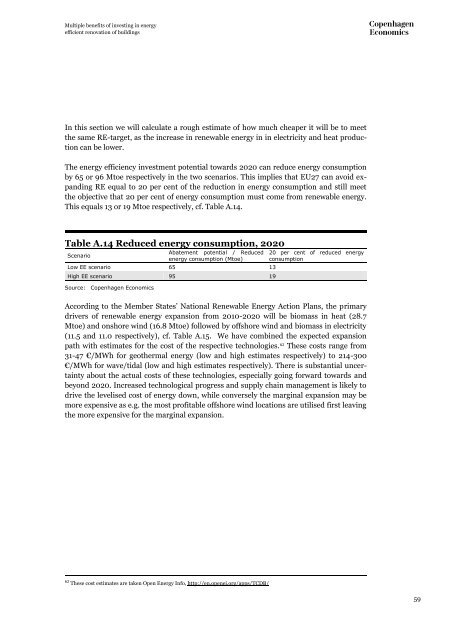Multiple benefits of renovation in buildings - PU Europe
Multiple benefits of renovation in buildings - PU Europe
Multiple benefits of renovation in buildings - PU Europe
You also want an ePaper? Increase the reach of your titles
YUMPU automatically turns print PDFs into web optimized ePapers that Google loves.
<strong>Multiple</strong> <strong>benefits</strong> <strong>of</strong> <strong>in</strong>vest<strong>in</strong>g <strong>in</strong> energy<br />
efficient <strong>renovation</strong> <strong>of</strong> build<strong>in</strong>gs<br />
In this section we will calculate a rough estimate <strong>of</strong> how much cheaper it will be to meet<br />
the same RE-target, as the <strong>in</strong>crease <strong>in</strong> renewable energy <strong>in</strong> <strong>in</strong> electricity and heat production<br />
can be lower.<br />
The energy efficiency <strong>in</strong>vestment potential towards 2020 can reduce energy consumption<br />
by 65 or 96 Mtoe respectively <strong>in</strong> the two scenarios. This implies that EU27 can avoid expand<strong>in</strong>g<br />
RE equal to 20 per cent <strong>of</strong> the reduction <strong>in</strong> energy consumption and still meet<br />
the objective that 20 per cent <strong>of</strong> energy consumption must come from renewable energy.<br />
This equals 13 or 19 Mtoe respectively, cf. Table A.14.<br />
Table A.14 Reduced energy consumption, 2020<br />
Scenario<br />
Abatement potential / Reduced<br />
energy consumption (Mtoe)<br />
Low EE scenario 65 13<br />
High EE scenario 95 19<br />
Source: Copenhagen Economics<br />
20 per cent <strong>of</strong> reduced energy<br />
consumption<br />
Accord<strong>in</strong>g to the Member States’ National Renewable Energy Action Plans, the primary<br />
drivers <strong>of</strong> renewable energy expansion from 2010-2020 will be biomass <strong>in</strong> heat (28.7<br />
Mtoe) and onshore w<strong>in</strong>d (16.8 Mtoe) followed by <strong>of</strong>fshore w<strong>in</strong>d and biomass <strong>in</strong> electricity<br />
(11.5 and 11.0 respectively), cf. Table A.15. We have comb<strong>in</strong>ed the expected expansion<br />
path with estimates for the cost <strong>of</strong> the respective technologies. 62 These costs range from<br />
31-47 €/MWh for geothermal energy (low and high estimates respectively) to 214-300<br />
€/MWh for wave/tidal (low and high estimates respectively). There is substantial uncerta<strong>in</strong>ty<br />
about the actual costs <strong>of</strong> these technologies, especially go<strong>in</strong>g forward towards and<br />
beyond 2020. Increased technological progress and supply cha<strong>in</strong> management is likely to<br />
drive the levelised cost <strong>of</strong> energy down, while conversely the marg<strong>in</strong>al expansion may be<br />
more expensive as e.g. the most pr<strong>of</strong>itable <strong>of</strong>fshore w<strong>in</strong>d locations are utilised first leav<strong>in</strong>g<br />
the more expensive for the marg<strong>in</strong>al expansion.<br />
62 These cost estimates are taken Open Energy Info, http://en.openei.org/apps/TCDB/<br />
59
















